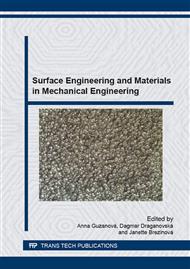p.61
p.65
p.69
p.74
p.78
p.83
p.89
p.93
p.97
Properties Evaluation of Renovation Coatings Created by Thermal Spraying Technology
Abstract:
Article deals with the assessment of the properties of ceramic coatings created by thermal spraying technology. Surfaces before coatings deposition were prepared by technology of pneumatic blasting. ZrSiO4 coating was applied by gas plasma spraying method with NiAl intermediate layer. Mullite coating was applied by water plasma spraying without the intermediate layer and also with NiCr intermediate layer. The quality of the coatings was evaluated by three criteria: adherence of the coatings, REM analysis and EDX analysis. In terms of adhesion of the coatings was found out, that the best properties showed Mullite coating deposited without intermediate layer.
Info:
Periodical:
Pages:
78-82
Citation:
Online since:
May 2015
Authors:
Keywords:
Price:
Сopyright:
© 2015 Trans Tech Publications Ltd. All Rights Reserved
Share:
Citation:


